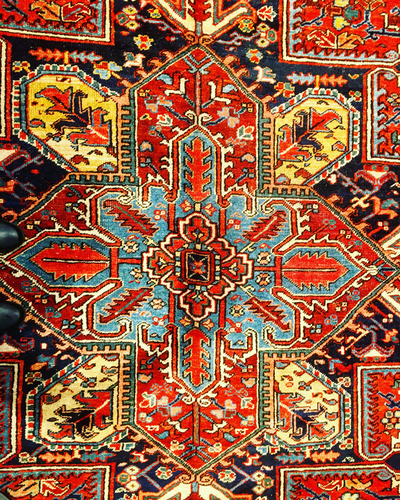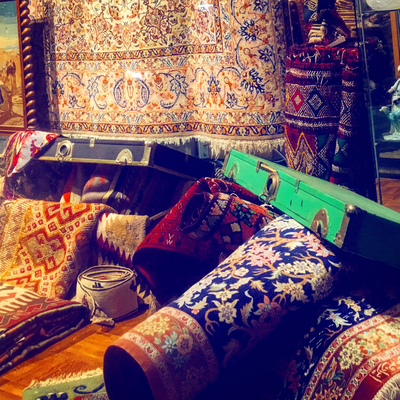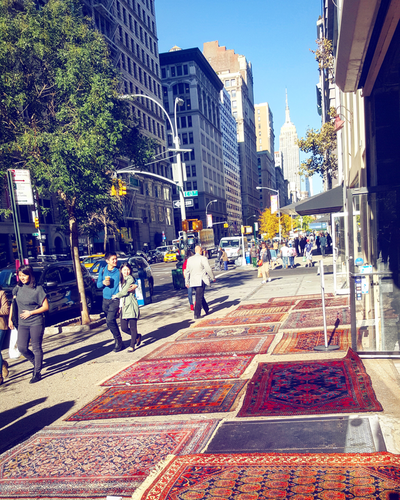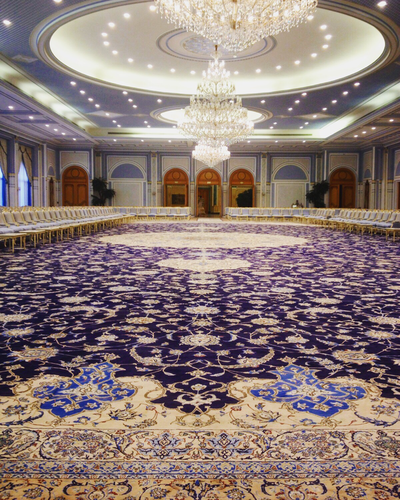Happy Sizdeh Bedar!! It's the last day of Norooz celebrations so make sure you spend it outdoors and with loved ones! "After 13 days of celebrations, Sizdeh Bedar is celebrated, which literally means “getting rid of the thirteenth.” Families throw green sprouts into rivers or lakes to symbolize the plant’s return to nature and conclude the festivities until the next year. We also tie a knot in grass and make a wish and prayer for the new year!" http://m.huffpost.com/us/entry/norooz-2016-dates-traditions-and-history-of-the-persian-new-year_us_56f032fce4b09bf44a9df896
This is our "Haft Seen" Spread at the New York Gallery for this Norooz! Happy Norooz! Happy Spring!3/29/2016 The main items are:
1. Somagh (sumac) : symbolizes the color of sunrise 2. Serkeh (vinegar): symbolizes age and patience 3. Senjed (dried fruit from lotus tree): symbolizes love 4. Samanoo (sweet pudding): symbolizes affluence 5. Sabzeh (sprouts): symbolizes rebirth 6. Sib (apple): symbolizes health and beauty 7. Sir (garlic): symbolizes medicine Additional items that begin with the letter “s” that are commonly seen on the Sofreh are: Sekkeh (coin): symbolizes wealth and prosperity Sonbol (hyacinth): a spring spring flower Other items included are: Mahi (fish): symbolizes life Tokhmeh Morgh (egg): symbolizes fertility Sham (candle): symbolizes enlightenment Shirini (sweets): symbolizes spreading the sweetness A book of poetry or prayer The Persian New Year, Norouz coincides with the Spring Equinox. I love this aspect of our culture because when the new year begins, it really feels like a beginning as the transition from winter into spring is seen in natures and felt in the air. Norouz is very much so of a cultural celebration in Iran and has been celebrated for centuries. It is customary for families to gather around the Haft Seen at the moment of the Spring Equinox and celebrate the transition from winter into spring together. The elders present family members with Eidee, which is a small monetary presents for Norouz. Have you set up your Haft Seen yet?  Nowruz is the traditional Persian festival of spring which starts at the exact moment of the vernal equinox, commencing the start of the spring. It is considered as the start of the New Year among Persians. The name comes from Avestan meaning "new day/daylight". Nowruz is celebrated March 20/21 each year, at the time the sun enters Aries and Spring begins. The name of Noruz does not occur until the second century AD in any Persian records. We have reasons to believe that the celebration is much older than that date and was surely celebrated by the people and royalty during the Achaemenid times (555-330 BC). It has often been suggested that the famous Persepolis Complex, or at least the palace of Apadana and Hundred Columns Hall, were built for the specific purpose of celebrating Noruz. However, no mention of the name of Noruz exists in any Achaemenid inscription. Our oldest records of Noruz go back to the Arsacid/Parthian times (247 BC-224 AD). There are specific references to the celebration of Noruz during the reign of Arsacid Emperor Vologases I (51-78 AD). Unfortunately, the lack of any substantial records about the reign of the Arsacids leaves us with little to explore about the details of Noruz during their times. After the accession of Ardashir I Pabakan, the founder of the Sasanian Dynasty (224 AD), consistent data for the celebration of Noruz were recorded. Throughout the Sasanian era (224-650 AD), Noruz was celebrated as the most prominent ritual during the year. Most royal traditions of Noruz such as yearly common audiences, cash gifts, and pardon of prisoners, were established during the Sasanian era and they persisted unchanged until the modern times. Noruz, along with Sadeh that is celebrated in mid-winter, were the two pre-Islamic celebrations that survived in the Islamic society after 650 AD. Other celebrations such Gahanbar and Mehragan were eventually side-lined or were only followed by the Zoroastrians who carried them as far as India. Noruz, however, was most honoured even by the early founders of Islam. There are records of the Four Great Caliphs presiding over Noruz celebrations, and during the Abbasid era, it was adopted as the main royal holiday. Following the demise of the Caliphate and re-emergence of Persian dynasties such as the Samanids and Buyids, Noruz was elevated into an even more important event. The Buyids revived the ancient traditions of Sasanian times and restored many smaller celebrations that had been eliminated by the Caliphate. Even the Turkish and Mongol invaders of Iran did not attempt to abolish Noruz in favor of any other celebration. Thus, Noruz remained as the main celebration in the Persian lands by both the officials and the people. During the Noruz holidays people are expected to pay house visits to one another (mostly limited to families, friends and neighbours) in the form of short house visits and the other side will also pay you a visit during the holidays before the 13th day of the spring. Typically, on the first day of Noruz, family members gather around the table, with the Haft Seen on the table or set next to it, and await the exact moment of the arrival of the spring. At that time gifts are exchanged. Later in the day, on the very first day, the first house visits are paid to the most senior family members. Typically, the youngers visit the elders first, and the elders return their visit later. The visits naturally have to be relatively short, otherwise one will not be able to visit everybody on their list. Every family announces in advance to their relatives and friends which days of the holidays are their reception days. A visit generally lasts around 30 minutes, where you often run into other visiting relatives and friends who happen to be paying a visit to the same house at that time. Because of the house visits, you make sure you have a sufficient supply of pastry, cookies, fresh and dried fruits and special nuts on hand, as you typically serve your visitors with these items plus tea or syrup. Many Iranians will throw large Noruz parties in a central location as a way of dealing with the long distances between groups of friends and family. Some Noruz celebrants believe that whatever a person does on Noruz will affect the rest of the year. So, if a person is warm and kind to their relatives, friends and neighbors on Noruz, then the new year will be a good one. On the other hand, if there are fights and disagreements, the year will be a bad one. Also, many people do a significant amount of "Spring Cleaning" prior to Noruz to rid the house of last year's dirt and germs in preparation for a good new year. One tradition that may not be very widespread (that is, it may belong to only a few families) is to place something sweet, such as honey or candy, in a safe place outside overnight. On the first morning of the new year, the first person up brings the sweet stuff into the house as another means of attaining a good new year. The traditional herald of the Noruz season is called Haji Pirooz, or Hadji Firuz. He symbolizes the rebirth of the Sumerian god of sacrifice, Domuzi, who was killed at the end of each year and reborn at the beginning of the New Year. Wearing black make up and a red costume, Haji Pirooz sings and dances through the streets with tambourines and trumpets spreading good cheer and the news of the coming New Year. The thirteenth day of the New Year festival is called Sizdah Bedar (meaning "thirteen outdoors"). It often falls on or very close to April Fool's Day, as it is celebrated in some countries. People go out in the nature in groups and spend all day outdoors in the nature in form of family picnics. It is a day of festivity in the nature, where children play and music and dancing is abundant. On this day, people throw their sabzeh away in the nature as a symbolic act of making the nature greener, and to dispose of the bad luck that the sprouts are said to have been collecting from the household. The thirteenth day celebrations, Seezdah Bedar, stem from the belief of the ancient Persians that the twelve constellations in the Zodiac controlled the months of the year, and each ruled the earth for a thousand years. At the end of which, the sky and the earth collapsed in chaos. Hence, Noe-Rooz lasts twelve days and the thirteenth day represents the time of chaos when families put order aside and avoid the bad luck associated with the number thirteen by going outdoors and having picnics and parties. At the end of the celebrations on this day, the sabzeh grown for the Haft Seen spread (which has symbolically collected all the sickness and bad luck) is thrown away into running water to exorcise the demons (divs) and evil eyes from the house hold. It is also customary for young single women to tie the leaves of the sabzeh, prior to discarding it, symbolizing their wish to be married before the next year's Seezdah Bedar. When tying the leaves, they whisper. Pazyryk: The first surviving pile rugThe oldest known hand knotted rug which is nearly completely preserved, and can, therefore, be fully evaluated in every technical and design aspect is the “Pazyryk carpet”, dated to the 5th century BC. It was discovered in the late 1940s by the Russian archeologist Sergei Rudenko and his team. The carpet was part of the grave gifts preserved frozen in ice in the Scythian burial mounds of the Pazyrak area in the Altai Mountains of Siberia. The provenience of the Pazyryk carpet is under debate, as many carpet weaving countries claim to be its country of origin.[17] Wherever it was produced, its fine weaving in symmetric knots and elaborate pictorial design hint at an advanced state of the art of carpet weaving at the time of its production. The design of the carpet already shows the basic arrangement of what was to become the standard oriental carpet design: A field with repeating patterns, framed by a main border in elaborate design, and several secondary borders.
There’s an art to designing, but sometimes we forget that there’s also an incredible art in the making of handmade products, too.
What I’ve always found fascinating about rugs was the amount of time, skill and dedication that each one takes to create. Rug making is meticulous work that can take anywhere from a few months to several years to make a given rug. The long hours, hard work and artistry that’s put into each work of art is remarkable. The talent of the people who make them. Coming from generations of rug-makers, the artisans put a lot more than just their time and energy into these textiles—each rug feels like a labor of love. The digital manipulation of images is something that has caused much soul searching in some sectors of the publishing industry, but until now, this is not a subject that has bothered our hallowed turf. While celebrities and starts have been airbrushed with a twinkle and wrinkle of everlasting youth, rugs have stoically remained unadulterated stars of the past, unimpeachable celebrations of the beneficial effects of age and patina.
The handmade carpet continues its remarkable journey and is reaching a new angle of appreciation in terms of its design and increasing popularity. The clean lines and simple modern minimalistic interiors that most of us live in and work in are hungry for a touch of color, design and history. Once again we are realizing the potential of these works of art. Handmade rugs are points of distinction and motifs of personal taste within an interior. A rug’s ability to transform a room, to set a mood, to provide comfort and texture, and designate a function to a space make it an essential element to any interior.
|
@KermanshahGalleryFollow us here, Instagram, Twitter, Facebook and Pinterest! We hope we inspire you! Archives
April 2016
Categories |























 RSS Feed
RSS Feed